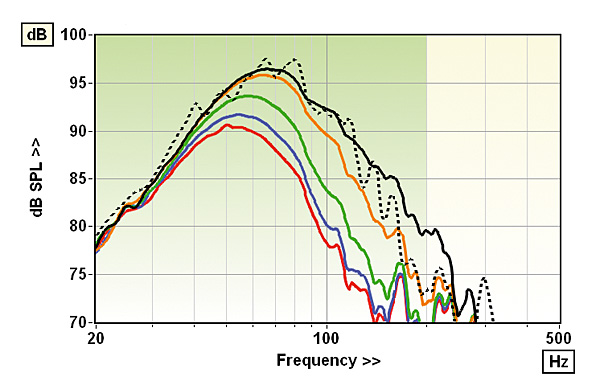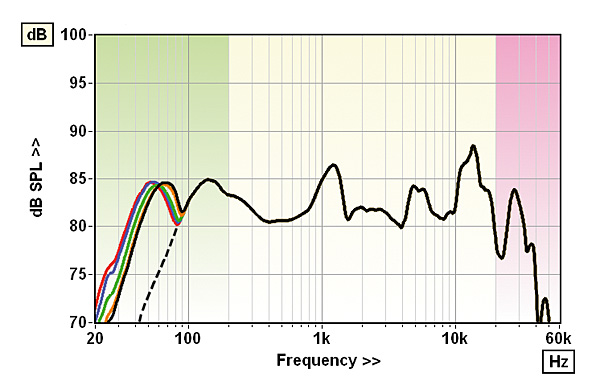Rogers AB3a Subwoofer Lab Report
Tested with the latest 15ohm LS3/5A, also from Rogers, the sheer 'adjustability', and placement scenarios, of the AB3a provokes a baffling array of possible response combinations. As a result, I will focus on the corrected, nearfield (free space) performance of this combination. The LS3/5A's 110mm Bextrene bass/mid unit is tuned with a ~5dB uplift at 143Hz (effective bandwidth is 75Hz-334Hz, –6dB) followed by a 2nd-order roll-off which, when used as a satellite, endows this little speaker with a limited 75Hz bass extension (–6dB re. 200Hz). However, when optimally integrated with the AB3a subwoofer, this takes the system down to 38Hz regardless of the 40Hz-240Hz low-pass setting.
That's the headline figure – the detail is at the mercy of LPF, phase and gain (level). For example with the LPF set to 80Hz, and positive (0o) absolute phase, the on-axis –6dB bandbass is 32Hz-86Hz (55Hz peak). In practice, increasing the low pass corner frequency from 40Hz all the way up to 240Hz results in a shift in the AB3a's tuned frequency from 52Hz up to 67Hz and the working bandpass from 32Hz-85Hz to 40Hz-111Hz (all re. –6dB). As important is the progressive +6dB uplift in output across the span of these LPF settings [see Graph 1 – 240Hz, black; 180Hz, orange; 120Hz, green; 80Hz, blue; 40Hz, red]. The dashed black trace is the same measurement taken in a corner location at the widest 240Hz LPF setting. The peaks and dips seen here centred around 40Hz, 50Hz, 65Hz are cancellations and reinforcements that will vary in frequency and amplitude according to distance.
Correcting for level and merging the nearfield outputs of the LS3/5A and the AB3a reveals a –3.5dB dip at 90Hz [Graph 2]. In practice, this could be ameliorated by boundary placement and tuning of the phase control. In theory, with the same turnover frequencies (not exactly so here), then we naturally end up with a +90° phase shift at crossover from the LS3/5A's 2nd-order roll-off and –90° from the sub. This yields 180° and a dip in the overall response. The solution is to steadily invert the polarity of the AB3a's output to 'fill-in' the dip at 90Hz. Good luck! PM


| Pair matching (30Hz–130Hz) | +0.5dB |
| LF extension (–6dB ref 200Hz) | 38Hz (with LS3/5A) |
| THD 40Hz/100Hz (for 85dB SPL/1m) | 1.5% / 0.8% |
| Dimensions (HWD) / Weight (each) | 600x190x165mm / 11kg |
| Price (pair): £3499 (RAL colours to order) |
























































